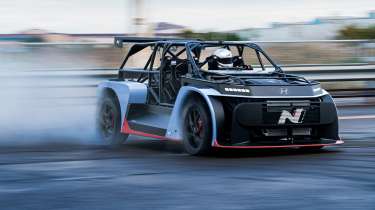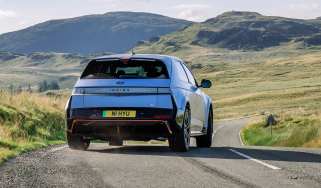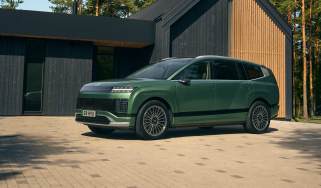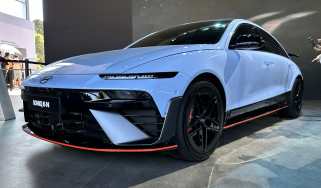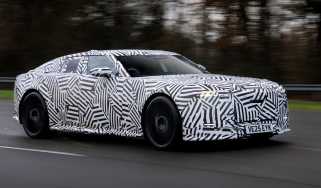New Hyundai Insteroid – could this be the new-age i20 N EV?
Hyundai has served up another wild hot hatch concept, this time taking the Inster supermini as a base. Could an electric successor to the i20 N be on the cards?
With the Ioniq 5 N, Hyundai proved it has what it takes to create a memorable, engaging electric car, but it’s not stopping there. A hot version of the Ioniq 6 saloon is on the way, and further down the line, we could see some of the N division’s EV tech being applied to a smaller, cheaper model. The radical new Insteroid concept, based on the Inster supermini, is a hint at what such a car could be like.
If the Insteroid looks vaguely familiar, it’s because it isn’t Hyundai’s first crack at a wild, high performance electric supermini. Last year’s RN24 concept – considered a ‘rolling lab’ by Hyundai – demonstrated what kind of performance and chassis tech could be packed into an i20-sized B-segment model, using a 641bhp powertrain from the 5 N, WRC-style configurable dynamic modes and an ‘e-Handbrake’. On the face of it, the Insteroid looks similar to the RN24 but with full bodywork in place of the rudimentary exposed exoskeleton of last year’s concept.
Tech specs are thin on the ground, but the Insteroid is built using lightweight lattice structures, and features a drift mode – as is customary for a modern performance EV. The widened body covers track-spec wheels, and there are vented wheelarches, a rear wing and diffuser to improve aero performance. The design is clearly closer to fantasy than production, but being Hyundai’s second small hot hatch concept, we wouldn’t be surprised if the firm is working on a production model of some sort behind the scenes.
A small EV packed with some of the N division's sophisticated powertrain and chassis tech would ease the pain somewhat after Hyundai axed its first and only hot supermini – the i20 N – last year. The N division’s Executive Technical Advisor, Albert Biermann previously confirmed to evo that all future N-badged electric cars would be designed for track use, and will therefore require an 800v electronic architecture for improved heat management and charging speeds for continuous flat-out driving.
At the moment, this tech is too costly to include in a small, affordable EV – not least the Inster, which uses a platform derived from ICE models – but once it trickles down to smaller segments, Hyundai could feasibly create an electric successor to the i20 N. If it looks anything like the Insteroid with the Ioniq 5 N’s chassis tech underpinning it, we could be in for a treat.
Hyundai RN24 technical details
The RN24 offers a glimpse at the EV performance car tech Hyundai is working on behind the scenes, and could make its way to N road cars at some point. Following the likes of the RN22E and N Vision 74, the concept is built around a bespoke chassis, but features many components that are already in production in the Ioniq 5 N. It’s no surprise, then, that it produces the same peak of 641bhp from a dual-motor, all-wheel drive powertrain, powered by an 84kWh battery pack.
While its powertrain might seem identical to the Ioniq 5 N’s on paper, Hyundai has reconfigured the battery pack to reduce its footprint while retaining the same capacity. The result is a 340mm reduction in wheelbase, allowing for improved agility and bringing the mule down to B-segment size to match the i20. Since it features the same battery chemistry as the Ioniq, weight is still on the high side at a predicted c1880kg.
The Ioniq 5 N is known to be one of the best performance EVs on the market for track use, with a powerful heat management system to maintain performance for lap after lap. Regardless, Hyundai’s engineers have worked to improve it further, modifying battery and motor systems to boost longevity.
In addition to the Ioniq 5 N’s existing artificial sound generator, the RN24 has also been equipped with a ‘high-output’ dual-speaker external sound system, using the rear bumper to amplify sound. While this certainly won’t be for some, our time in the 5 N has made it clear that regardless of how synthetic these sounds may be, they can improve the driving experience when calibrated correctly.
What makes the RN24 really special is the adoption of WRC-inspired chassis technology, with its new suspension system configured with ‘rally-spec’ dampers and improved subframe rigidity. Steering is also faster for better response, and while it’s unlikely to make it to production, that wild-looking exoskeleton cage improves overall stiffness too.
Also taking notes from WRC is its ‘Powertrain Drive Control Logic system’, allowing the driver to adjust parameters for the throttle, regenerative braking and power balance directly on the steering wheel. There’s also a torque vectoring mode specifically designed to replicate the dynamics of a rally car, and a new ‘e-Handbrake’ to eliminate the need for a costly hydraulic system – this was even tested on a recent stage of the WRC’s Central European Rally.
Hyundai RN24 specs (targeted)
| Powertrain | Dual-motor, all-wheel drive |
| Power | 641bhp (with boost) |
| 0-62mph | <3.4sec |
| Top speed | 149mph |
| Battery | 84kWh |
| Weight | c1880kg |


